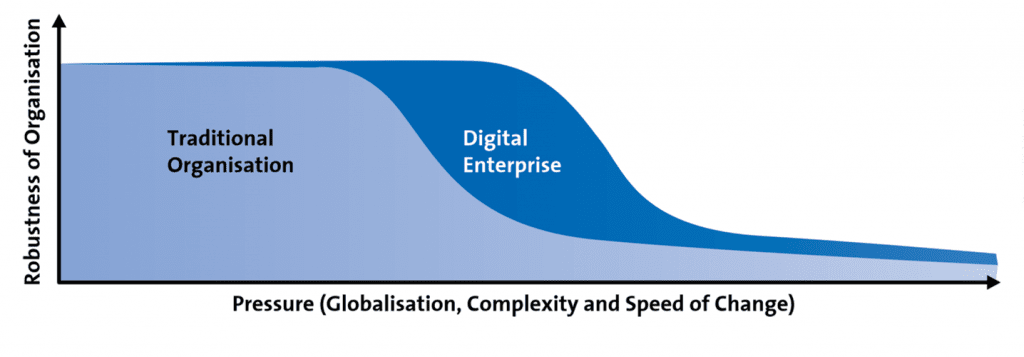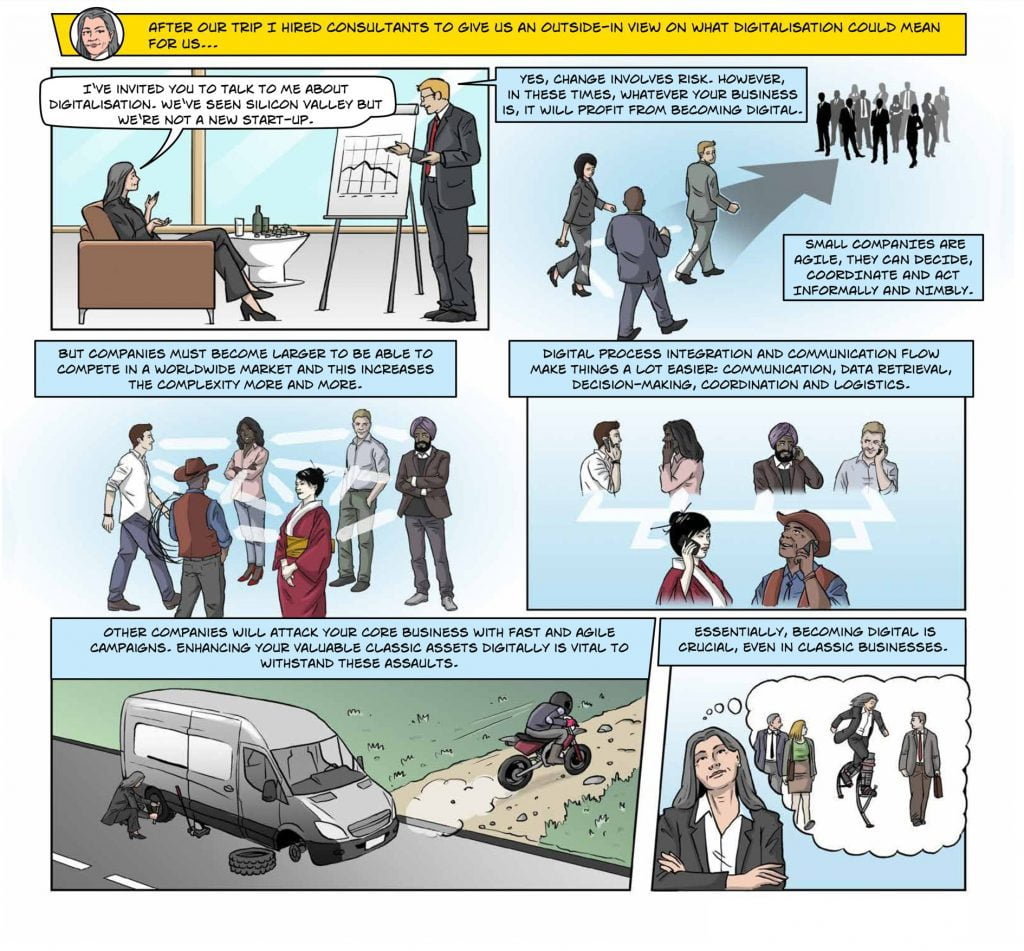The previous chapter discussed how digitalisation brings a new kind of relationship between companies, customers, employees and suppliers, resulting in new business models.[1], [2] These business models are increasingly replacing established models from the nineteenth and twentieth centuries, creating large pressure for companies to act differently. In addition to achieving the main objective of better market positioning, these changes can also offer other desirable results, such as the opportunity for companies to be far more efficient and sustainable as a result of the digital transformation.

The following discussion is based on the observation that companies increasingly encounter a variety of growth limits that they cannot easily overcome.
Globalisation, size, complexity and speed of change typically trouble many companies. Since traditional approaches to solving these problems seem to have lost their effectiveness, new approaches are often sought.
Environmental scandals and financial crises provide evidence that companies want to move beyond the natural limits of their capacity and often find no appropriate means to achieve it.[3] It should be emphasised again that digitalisation is not a panacea – the results could be undesirable if digitalisation measures are applied in the wrong way.
Therefore, it is important to accurately analyse the company’s market position and performance, and use this analysis to develop an individually coordinated strategy so that the benefits of digitalisation help the company grow robustly.
This chapter analyses different causes of the disruption that often affect today’s companies and comments on how digitalisation can help better manage such disruption.
First, we address the growth of large enterprises. In a stock market-driven world, growth is an important success factor in many cases, even for very large companies. It may be that new markets are conquered, additional products are added to the portfolio, or simply larger amounts of goods or services are produced, sold and distributed. In any case, today´s companies experience barriers that often can no longer be overcome by conventional means. One of the greatest obstacles here is organisational complexity. Beyond a certain critical size, the company’s performance decreases as the number of employees increases. This is the case when the value of new employees’ contribution is less than the organisational effort needed to realise that contribution. The same applies to new locations, products, countries, etc. If this point is reached, only a paradigm shift can help, as could be achieved in the process of digitalisation. These digitalisation benefits apply to organic growth as well as to buyouts and mergers.
In addition to growth, enormous gains in operational efficiency have been driven forward since the Industrial Revolution. Most processes have been optimised and automated, and employee training has been improved. In many companies, however, the limits of such improvements have been reached, which cannot be overcome by traditional means. For example, many traditional production processes have already been automated to an extent that small teams can handle them; further automation efforts will not bring much improvement in efficiency, at least in the conventional sense.
Only the use of intelligent data analysis, automated decision support, or new means of communication can make further improvements possible in such situations.
Companies are becoming increasingly overwhelmed by marketing and sales activities in a diversified and globalised world.[4], [5] Selling into a global market requires a fundamentally different skill set than selling into a manageable, local market.
Scaling up known concepts at a global level often fails.[7] Half-hearted digitalisation of sales processes – often driven by initiatives under the title ‘CRM’ (customer relationship management) or ‘sales management’ – falls short because such actions only digitise old ways of thinking. A new calibre of sales can only be achieved through the consistent use of new channels for customer contact, data analysis and individualisation.[6]
Driving growth to current limits and beyond through the optimisation of production and distribution by traditional means will always lead to a dehumanisation of work.[8] Employees are considered resources and staff are exposed to the full external pressure. Reorganisations, work intensification, out- and insourcing activities, etc., result in an increasing alienation of employees from their companies, leading to a dramatic decline in productivity and ultimately even to mental illness. Especially in global companies with virtual teams and flexible workplace concepts, it becomes nearly impossible to counter this trend.
Due to new organisational and communication concepts, along with increased transparency, digitalisation opens up the opportunity to create a new employee identity.
However, this will only succeed if ethical and social principles are an integral part of the digitalisation contract.
One example that drastically shows that corporate robustness and digitalisation go hand in hand is in the energy industry. A major shift to utilising renewable energy sources to charge electric cars is taking place, facilitating truly green transport. Doing this without a thorough understanding of the impacts can potentially lead to network disruption because the characteristics of power production, transmission and consumption fundamentally change.
Ignoring the need for better data analysis and real-time decision support leads to the inability to supply a future market, or even to instability and blackouts on the network. At the same time, digitalisation provides a tool set to allow the prediction and control of demand to fit the capacity of the existing network.
This example also shows that digitalisation is not a luxury, but rather an investment into mission-critical enterprise capabilities.
_____
[1] Ingleton, R., Ozler, Y., Thomas, P.: ‘The digitisation of everything – How organisations must adapt to changing consumer behaviour’, Ernst & Young, pp. 10, 2011.
[2] Baines, T.: ‘Bringing production and service together’, Raconteur Media Ltd, 2014. 37
[3] Nagata, K.: ‘Pressure to show a profit led to Toshiba’s accounting scandal’, The Japan Times Online, 2015.
[4] Beutin, N., Pumberger D.: ‘Was bedeutet die Digitalisierung für den Vertrieb’, Haufe Online-Redaktion, p. 1, 2013.
[5] Franken, A.: ‘Die Digitalisierung verändert Märkte – Verkauft wird aber zu oft noch analog’, Vertriebsmanager, p. 1, 2016.
[6] Porter, M. E., Heppelmann, J. E.: ‘Wie smarte Produkte den Wettbewerb verändern’, Harvard Business Manager, 2014.
[7] Geissbauer, R., Vesdø, J., Schrauf, S.: ‘A Strategist’s Guide to Industry 4.0’, strategy+business, p. 2, 2016.
[8] Illek, C. O.: ‘Die Menschen mitnehmen – Wir laufen Gefahr, als Wissensgesellschaft zu versagen, und gefährden so unsere Zukunft’, Die Süddeutsche Zeitung Online, 2015.



